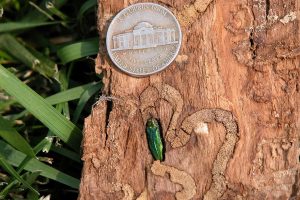
Understanding Emerald Ash Borers
Emerald ash borers, scientifically known as Agrilus planipennis, are small beetles with striking green armor. Originally from Asia, these invasive pests have become a serious threat to ash trees in the United States and Europe. The larvae of emerald ash borers feed on ash tree wood, causing extensive damage and ultimately leading to tree mortality.
Winter Survival of Emerald Ash Borers
Adaptation to Cold Climates
Emerald ash borers are no strangers to cold weather. In their native regions of Russia, China, Korea, and Japan, they have adapted to temperatures that frequently drop below zero degrees Celsius. These beetles have natural predators, such as Asian wasps, that help keep their populations in check. However, in areas where these predators are absent, like Canada and parts of the United States, emerald ash borers have caused significant destruction.
Surviving Freezing Temperatures
While it may seem logical to assume that cold winter temperatures would eliminate emerald ash borers, the reality is more complex. Research suggests that these pests can survive temperatures as low as -13˚F (-25˚C), provided they have had time to acclimate to the cold. However, sudden drops in temperature can be more detrimental to the larvae. When exposed to freezing conditions without prior acclimation, only a small percentage of emerald ash borer larvae are likely to survive.
Duration of Freezing Weather
The duration of freezing weather also plays a role in the survival of emerald ash borers. If a frost persists for 24 hours or longer, more larvae tend to perish compared to intermittent frost periods. Therefore, it is not safe to rely solely on cold weather to control emerald ash borer populations.
Signs of Emerald Ash Borer Infestation
To determine if your ash trees are infested with emerald ash borers, it is important to be aware of the signs and symptoms. These indicators may be more evident during fall and winter when foliage is sparse. Look out for the following warning signs:
- Bark Splitting: Check for cracks or splits in the bark, especially near the base of the tree.
- S-Shaped Galleries: Emerald ash borers create distinct S-shaped tunnels under the bark of infested trees.
- Increased Woodpecker Activity: Woodpeckers feed on emerald ash borer larvae, so an uptick in woodpecker activity may indicate an infestation.
If you suspect an emerald ash borer infestation, it is crucial to take prompt action to protect your trees and prevent the spread of these destructive pests.
The Impact of Winter on Emerald Ash Borers
Winter Mortality and Adaptation
While winter weather can reduce emerald ash borer populations to some extent, it does not eliminate them entirely. Harsh winters may kill off weaker borers, but the surviving individuals possess genetic traits that allow them to withstand colder temperatures. Over time, this natural selection process can result in stronger and more resilient emerald ash borer populations.
Spread of Infestations
Winter also poses risks for the spread of emerald ash borer infestations. These pests can move from tree to tree, and the transportation of firewood can accelerate their spread, particularly during the cold months. It is essential to be cautious when handling firewood and to avoid moving potentially infested wood to new areas.
Controlling Emerald Ash Borers
Professional Pest Control
If you have confirmed or suspect an emerald ash borer infestation, it is recommended to seek professional assistance. Pest control companies specializing in tree care can effectively treat infested trees with pesticides specifically designed to target emerald ash borers. These treatments typically involve applying a specialized substance directly to the innermost part of the tree.
Biological Control
Another approach to managing emerald ash borers is through biological control methods. Introducing natural predators, such as woodpeckers, to the area can help control emerald ash borer populations. Woodpeckers feed on the larvae, reducing their numbers and limiting the damage caused to ash trees.
Tree Removal
In severe cases where an infestation has progressed significantly, tree removal may be necessary. Removing infested trees can help prevent the spread of emerald ash borers to neighboring trees and minimize the risk of further damage.
Resistant Ash Tree Species
It is worth noting that some ash tree species exhibit resistance to emerald ash borer infestations. Varieties such as Spathius galinae, Oobius agile, and Spathius agile have shown resistance to these destructive pests. If you plan to plant ash trees in areas affected by emerald ash borers, consider selecting these resistant species to mitigate the risk.
While cold winter weather can have some impact on emerald ash borer populations, it is not a foolproof method of control. These resilient pests can survive freezing temperatures and even adapt to harsh conditions over time. To effectively manage emerald ash borer infestations, it is essential to employ professional pest control, consider biological control methods, or, in severe cases, remove infested trees. Being proactive and taking appropriate measures can help protect your ash trees and prevent the spread of these destructive insects.
Contact us (859-314-LAWN) for more information or a free instant quote!
—
 About Green & Grow
About Green & Grow
Green & Grow is a full service lawn care company specializing in lawn mowing, fertilization & weed control, aeration & seeding, insect control, and more!
> Learn More

 About Green & Grow
About Green & Grow